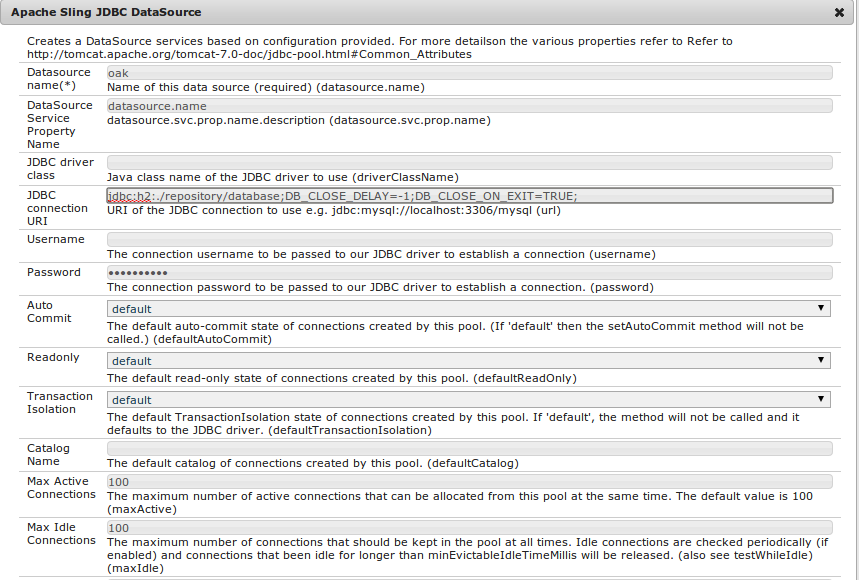DataSource Provider
DataSource provider bundle supports creation of DataSource instance and registering them with the OSGi service registry. Application using the DataSource just obtains it from OSGi while an administrator can configure the DataSource via Felix WebConsole configuration UI.
Pooled Connection DataSource Provider
This bundle enables creating and configuring JDBC DataSource in OSGi environment based on OSGi configuration. It uses Tomcat JDBC Pool as the JDBC Connection Pool provider.
- Supports configuring the DataSource based on OSGi config with rich metatype
- Supports deploying of JDBC Driver as independent bundles and not as fragment
- Exposes the DataSource stats as JMX MBean
- Supports updating of DataSource connection pool properties at runtime without restart
Driver Loading
Loading of JDBC driver is tricky on OSGi env. Mostly one has to attach the Driver bundle as a fragment bundle to the code which creates the JDBC Connection.
With JDBC 4 onwards the Driver class can be loaded via Java SE Service Provider mechanism (SPM) JDBC 4.0 drivers must include the file META-INF/services/java.sql.Driver. This file contains the name of the JDBC driver's implementation of java.sql.Driver. For example, to load the JDBC driver to connect to a Apache Derby database, the META-INF/services/java.sql.Driver file would contain the following entry:
org.apache.derby.jdbc.EmbeddedDriver
Sling DataSource Provider bundles maintains a DriverRegistry which contains mapping of Driver bundle to Driver class supported by it. With this feature there is no need to wrap the Driver bundle as fragment to DataSource provider bundle
Configuration
- Install the current bundle
- Install the JDBC Driver bundle
- Configure the DataSource from OSGi config for PID
org.apache.sling.datasource.DataSourceFactory
If Felix WebConsole is used then you can configure it via Configuration UI at http://localhost:8080/system/console/configMgr/org.apache.sling.datasource.DataSourceFactory

Using the config ui above one can directly configure most of the properties as explained in Tomcat Docs
Convert Driver jars to Bundle
Most of the JDBC driver jars have the required OSGi headers and can be directly deployed to OSGi container as bundles. However some of the drivers e.g. Postgres are not having such headers and hence need to be converted to OSGi bundles. For them we can use the Bnd Wrap command.
For example to convert the Postgres driver jar follow the steps below
$ wget https://github.com/bndtools/bnd/releases/download/2.3.0.REL/biz.aQute.bnd-2.3.0.jar -O bnd.jar
$ wget https://jdbc.postgresql.org/download/postgresql-9.3-1101.jdbc41.jar
$ cat > bnd.bnd <<EOT
Bundle-Version: 9.3.1101
Bundle-SymbolicName: org.postgresql
Export-Package: org.postgresql
Include-Resource: @postgresql-9.3-1101.jdbc41.jar
EOT
$ java -jar bnd.jar bnd.bnd
In the steps above we
- Download the bnd jar and postgres driver jar
- Create a bnd file with required instructions.
- Execute the bnd command
- Resulting bundle is present in
org.postgresql-9.3.1101.jar
JNDI DataSource
While running in Application Server the DataSource instance might be managed by app server and registered with JNDI. To enable lookup of DataSource instance from JNDI you can configure JNDIDataSourceFactory
- Configure the DataSource from OSGi config for PID
org.apache.sling.datasource.JNDIDataSourceFactory - Provide the JNDI name to lookup from and other details
If Felix WebConsole is used then you can configure it via Configuration UI at http://localhost:8080/system/console/configMgr/org.apache.sling.datasource.JNDIDataSourceFactory
Once configured JNDIDataSourceFactory would lookup the DataSource instance and register it with OSGi ServiceRegistry
Usage
Once the required configuration is done the DataSource would be registered as part of the OSGi Service Registry The service is registered with service property datasource.name whose value is the name of datasource provided in OSGi config.
Following snippet demonstrates accessing the DataSource named foo via DS annotation
import javax.sql.DataSource;
import org.apache.felix.scr.annotations.Reference;
public class DSExample {
@Reference(target = "(&(objectclass=javax.sql.DataSource)(datasource.name=foo))")
private DataSource dataSource;
}
Installation
Download the bundle from here or use following Maven dependency
<dependency>
<groupId>org.apache.sling</groupId>
<artifactId>org.apache.sling.datasource</artifactId>
<version>1.0.0</version>
</dependency>
